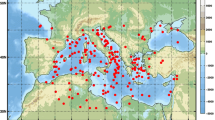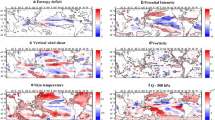Abstract
Tropical cyclones are non-frontal synoptic-scale warm-core low-pressure systems that originate over the tropical or subtropical oceans and contain organized deep convection and a well-defined cyclonic surface wind circulation. Tropical cyclones form over warm ocean waters, which supply energy to the atmosphere in the form of latent and sensible heat. Under favorable atmospheric thermodynamical conditions associated with low-level convergence a surface low develops into a cyclonic storm. The movement of the tropical cyclone is generally known by the knowledge of the upper atmospheric conditions and the prevailing circulations. Based on intensity, tropical cyclones in the Atlantic, Eastern, and Western Pacific are classified as a tropical depression for a weaker system with V max≤ 17 m/s (\( \approx \)62 km/h), a tropical storm for a moderate system with 18 m/s ≤ V max ◆ 32 m/s, and a hurricane or typhoon for a strong system with V max ≥ 33 m/s. Hurricanes are called major hurricanes when V max ≤ 50 m/s and typhoons are classified as super typhoons when V max ≤ 67 m/s. The maximum wind speed of a strong tropical cyclone may exceed 100 m/s, which may produce storm surge by driving an ocean rise of several meters along the coast. On the average about five tropical cyclones occur annually over the Bay of Bengal (Bhaskar Rao DV, Ashok K (1999) in the north Indian Ocean, which contributes 6% of the global annual frequency. Based on the maximum sustained winds associated with the system and geographical location of their occurrences, they are classified as depression, tropical storm, severe cyclone, or hurricane (Asnani 1993). There are two cyclone seasons in the north Indian Ocean, viz., pre-monsoon (especially May) and post-monsoon (October and November). A few cyclones can also form in the transitional monsoon months, June and September (i.e., arrival and withdrawl phase of the Indian summer monsoon).
Access this chapter
Tax calculation will be finalised at checkout
Purchases are for personal use only
Similar content being viewed by others
References
Anthes RA (1977) Hurricane model experiments with a new cumulus parametrization scheme. Mon Wea Rev 105:287-300
Asnani GC (1993) Tropical meteorology vols 1, 2. Published by Prof. G. C. Asnani, c/o Indian Institute of Tropical Meteorology, Dr. Homi Bhabha Road, Pashan, Pune-411008, India
Bhaskar Rao DV, Ashok K (1999) Simulations of tropical cyclone circulations over the Bay of Bengal. Part 1, description of the model, initial data and results of the control experiment. Pure Appl Geophys 156(3):525-542
Braun SA, Tao WK (2000) Sensitivity of high resolution simulations of hurricane Bob (1991) to planetary boundary layer parameterization. Mon Wea Rev 128:3941-3961
Grell GA, Dudhia J, Stauffer DR (1994) A description of the fifth generations Penn State/NCAR Mesoscale Model (MM5)/NCAR Technical Note NCAR/Tn 398 TSR, p 117
Singh OP et al (2001) Has the frequency of the intense tropical cyclones increased in the Indian Ocean. Curr Sci 80(4):575-580
Trivedi PM, Vaidya SS (2006) Impact of physical parameterization scheme on numerical simulation of Orissa Super cyclone (1999). Mausam 57(1):97-110
Acknowledgments
Authors are grateful to the Directorate General of Navigation and Meteorology, Oman and Director of forecasting and observing at Muscat airport. Authors are thankful to Director of Salalah Airport, Oman and Director of Indian Institute of Tropical Meteorology, Pune, India for supporting the collaborative work and extending the necessary facilities.
Author information
Authors and Affiliations
Corresponding author
Editor information
Editors and Affiliations
Rights and permissions
Copyright information
© 2010 Springer Science+Business Media B.V.
About this chapter
Cite this chapter
Najar, K.A.A., Salvekar, P.S. (2010). Understanding the Tropical Cyclone Gonu. In: Charabi, Y. (eds) Indian Ocean Tropical Cyclones and Climate Change. Springer, Dordrecht. https://doi.org/10.1007/978-90-481-3109-9_40
Download citation
DOI: https://doi.org/10.1007/978-90-481-3109-9_40
Published:
Publisher Name: Springer, Dordrecht
Print ISBN: 978-90-481-3108-2
Online ISBN: 978-90-481-3109-9
eBook Packages: Earth and Environmental ScienceEarth and Environmental Science (R0)




